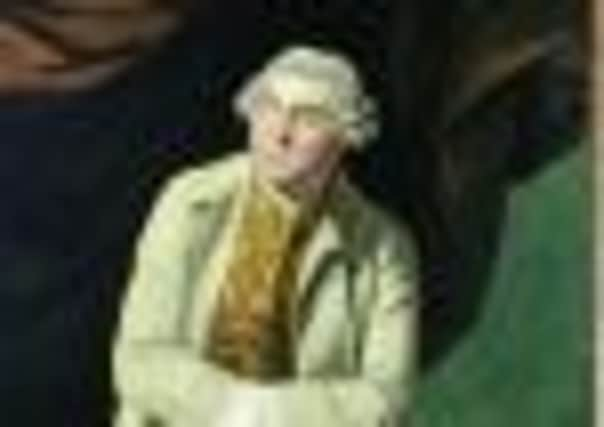Book review: Mr Foote’s Other Leg, by Ian Kelly


Mr Foote’s Other Leg
By Ian Kelly
Picador, 440pp, £18.99
I first read him purely by chance about 20 years ago: I had bought a five-volume set called “The British Drama: Comprehending the Best Plays in the English Language”, published in 1804 by William Miller and James Ballantyne. After two volumes of tragedies and two volumes of comedies there was a volume of “Operas and Farces”, featuring works such as John Gay’s The Beggar’s Opera. By far, the largest number of plays – Taste, The Author, The Patron, The Devil on Two Sticks, The Bankrupt, The Orators and more – were by Samuel Foote.
His name cropped up intermittently in my undergraduate years. Byron’s Hints from Horace has the lines “Farce follow’d Comedy, and reach’d her prime /In ever laughing Foote’s fantastic time, / Mad wag! who pardon’d none, nor spared the best, / And turn’d some very serious things to jest. / Nor church nor state escaped his public sneers, / Arms nor the gown, priests, lawyers, volunteers, / Alas, poor Yorick! now forever mute! / Whoever loves a laugh must sigh for Foote”.
Advertisement
Hide AdAdvertisement
Hide AdIn Boswell’s Life of Johnson, the great English moralist opined “Foote has the greatest range for his wit … he never lets truth stand between him and jest, though he is sometimes mighty coarse”. Furthermore “he has no principles and is governed neither by good manners nor discretion and very little by affection. But for a broad laugh, I must confess the scoundrel has no fellow!”
Ian Kelly’s splendid biography of Foote not only makes robust claims for his importance, but makes clear why he disappeared from the canon so rapidly. It is also the kind of life that seems almost novelistic. In truth, his life was already novelised. Before he became successful as a playwright and theatre manager, Foote had come to public attention with a tell-all, true-life crime story, about how one of his uncles had murdered the other. The title of the book refers to the fact that Foote had his leg amputated in 1766 (he was thrown from a horse during a dare set by the Duke of York). Foote had previously been notorious for his impersonation of the one-legged Irish publisher George Faulkner, whom he satirised as Peter Paragraph. On losing his own leg he purportedly quipped he could take off Faulkner even better now. In plays such as The Lame Lover, Foote played on his own disability. In part, what makes a Foote revival unlikely is that the plays were vehicles for Foote’s own comedic skills.
The end of Foote’s life was blighted by a court case, and Kelly provides a great deal of new evidence about it. Foote had aggravated the bigamous Duchess of Kingston, depicting her as Kitty Crocodile in A Trip To Calais. The duchess vowed revenge, and soon thereafter one of Foote’s servants accused him of assault and attempted homosexual rape. Although Foote was acquitted, his reputation never recovered: despite being a friend to Garrick, Johnson and many of the 18th-century wits, none of them attended his funeral. Kelly manages to get as close to the truth as we are likely to get, bringing in medical notes prepared by the surgeon John Hunter and even a piece of compelling evidence from a Sotheby’s sale catalogue. Was Foote gay, a kind of precursor to Oscar Wilde?
It is difficult to backwrite our concepts of sexuality on an earlier age, but there is enough other circumstantial evidence – Foote drank in “molly houses” and took part in a transvestite revue with the poet Christopher Smart – to suggest tentatively that he has a place in a history of gay literature. During the criminal proceedings, Foote took to the stage and acted a scene in which he is assaulted by a character who thinks he is a woman. The audience surely realised the context, and this blatancy goes a long way to prove Kelly’s contention that Foote’s accident led to a degree of disinhibition.
What is certain is that Foote transformed comedy in ways that are still with us today. His satirical lampooning of real people (including his friend Garrick, the Methodist preacher Whitefield and famous actresses of the day) paves the way towards Spitting Image; indeed Foote even pioneered the use of puppets. His skill at imitation finds a modern counterpart in Rory Bremner. He was more like a stand-up comedian in some ways than an actor.
My only reservation about the book is in terms of Kelly slightly holding the actual works at a distance. They are no more dated than many other plays of the period – the tragedies of Rowe and Otway or the comedies of Mrs Centlivre and Colley Cibber. The way in which pretention became a central concern resonates with a majority of the sitcoms produced in Britain in the 20th century, from Basil Fawlty to Hyacinth Bucket.
This thrilling piece of literary archeology should ensure that Foote is no longer a footnote, but seen as an integral part of the development of drama in the 18th century and beyond. The biographical quarry, like the man himself, remains twinklingly elusive – as Johnson said: “When you have driven him into a corner, he runs through between your legs, or jumps over your head, and makes his escape”.